Sun 14 Aug 2011
Movie Review: NIGHT OF THE QUARTER MOON (1959).
Posted by Steve under Films: Drama/Romance , Reviews[5] Comments
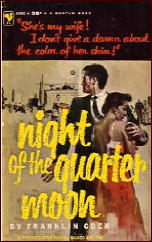
NIGHT OF THE QUARTER MOON. MGM, 1959. Also released as Flesh and Flame. Julie London, John Drew Barrymore, Anna Kashfi, Dean Jones, Agnes Moorehead, Nat “King†Cole, James Edwards, Cathy Crosby. Paperback adaption by Franklin Coen (Bantam, 1959). Producer: Albert Zugsmith. Director: Hugo Haas.
If nobody has ever written a full-length analysis of Hugo Haas’s directorial output, then someone should. He’s known, of course, by a small cult of followers and true believers for such films (lurid dramas) as Pickup (1951), The Girl on the Bridge (1951), Strange Fascination (1952), One Girl’s Confession (1952) and Bait (1954), all variations on a theme.
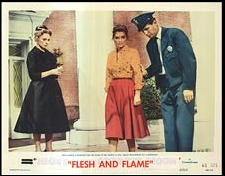
That theme being that of middle-aged men or older (often played by Haas himself) being lured into relationships (sexual, of course) with blonde tramps (well-built, of course, and usually played by Cleo Moore), with deadly results.
This, you may be sure, is the stuff that cults are made of, but even with limited budgets, the films (in my humble opinion) were made with some thought behind them, down to earth, and generally better than better critics than I have considered them to be.
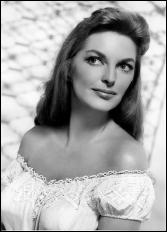
What could Haas have done with a major studio (MGM) and major money behind him? Well, first of all (deep breath here) Night of the Quarter Moon is not a major disaster, and while it has its faults – quite a few, in fact – there’s enough story line here to provide more than one PhD candidate with a considerable amount of material for more than one dissertation.
When John Drew Barrymore (a former Korean Conflict prisoner-of war) meets Julie London in Mexico, he doesn’t care that she’s one quarter black (Portuguese-Angolan), but his rich mother (the imperious Agnes Moorehead) back in San Francisco does, when she finds out.
And equally so do his neighbors, who fear their property values are going to plummet, and who don’t fail to let the newly married couple know about it after they move in.
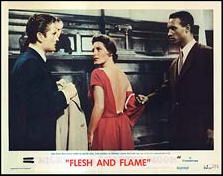
Mama, in fact, takes the case to court to get the marriage annulled, while keeping her son under sedation and incommunicado, her contention being that he wasn’t told of his bride’s unfortunate background before the wedding.
Which leads inexorably to the most overblown (and provocative) portion of the film, an ending that by sheer audacity surely made audiences gasp at the time, and is still very effective now: Julie London’s character must strip in court to show her tan lines, or lack of them.
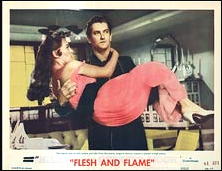
Well, OK, but in the context of the movie, it makes sense.
Julie London, who resembles nothing more than a less full-blown Jane Russell, but not much less, does very well as lady in the case, determined not to let her husband get away from her, and for the right reasons; and John Drew Barrymore, confused by his arrest and subsequent sedation, more than holds his own.
They make a good couple, mixed-race or not, and if nothing else, the movie might be remembered as a solid romance movie, even without strictly exploitative and over-the-top theatrics Hugo Haas uses to describe the situation they find themselves in, to put it mildly.
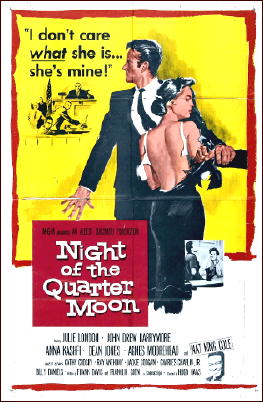
August 17th, 2011 at 11:30 pm
Certainly Leonard Maltin was on the Haas as hack bandwagon, when I first read about these films in the early editions of TV MOVIES…I’ve yet to see more than a minute or so of any of them, but considering some of the other cult directors worshiped these days, I’d be surprised if your review here is the only article with at least some appreciation for the Haas oeuvre…London’s participation might well make this the one to start with. Sort of a more self-mythologizing Douglas Sirk, you’re thinking, had he more of a bankroll behind him? A soapier Samuel Fuller?
August 17th, 2011 at 11:50 pm
Todd
Here’s one website in which Hugo Haas is discussed, with the title: More than just a “foreign Ed Wood.” I’m sure there are other places on the net where Haas comes up. I just haven’t looked yet.
http://www.radio.cz/en/section/czechs/hugo-haas-more-than-just-a-foreign-ed-wood
But here are two longish quotes:
“Naturally these [later] films are very low-budget, as he had very little resources at his disposal to shoot them. He made them as cheap, small-scale projects for as little money as possible. But if we take account of the fact that so many famous directors from the Old World ended up in America after the war, and so many of them didn’t make it, then we have to look at what Hugo Haas managed to achieve as a success.”
and
“The tragic fate of his family and of Jews in general really left its mark on him. This also manifested itself in his work. He tended to seek refuge in melancholy. Sometimes it was even a little bit kitsch. Most of the characters he played later on were old men who were all alone and who nobody was interested in. These characters usually fell for a younger woman, but their love would invariably turn out to be nothing but a false illusion and they quickly ended up having to face the harsh reality of their situation. These scenarios pretty much tied in with Haas’s own personal feelings about living abroad and the melancholy of his exile.”
August 17th, 2011 at 11:43 pm
Oddly enough, the NYT 17 hours ago, says Google, posted their second-string reviewer Howard Thompson’s mixedly negative review of the film (Bosley Crowther was their inferior first-stringer, though Gordon misses the whole tan-line thing).
http://movies.nytimes.com/movie/review?res=9F02E0D7173DE73ABC4D53DFB5668382649EDE
August 17th, 2011 at 11:58 pm
That’s a mixed review, all right, but except for the tan lines aspect, I don’t find a lot to quarrel with.
Incidentally, to answer your other question, Sam Fuller is a good pick as a director to compare Haas to, but not entirely favorably, in my opinion. But if Fuller worked with a low budget, then Haas had even less — a lot less.
February 9th, 2019 at 1:59 pm
I love Hugo Haas.But he is a large step below Sam Fuller?